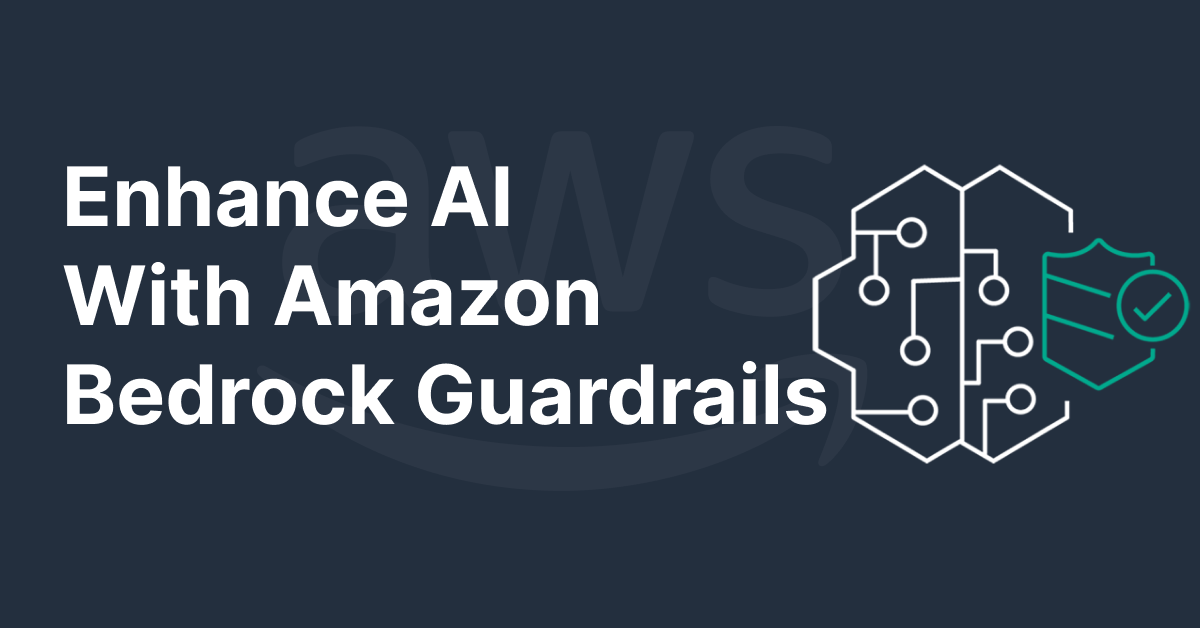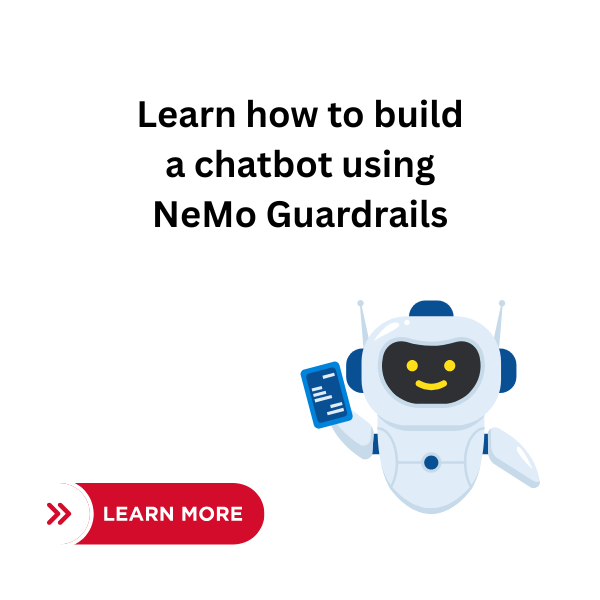Evolution of Amazon Bedrock Guardrails: Enhancing Generative AI with New Capabilities
Smarter Guardrails for Safer AI

The era of unchecked AI experimentation is giving way to a new imperative, responsible innovation. As generative AI becomes foundational to business strategy, organizations must embed trust and control at the core of their AI ecosystems. Amazon Bedrock Guardrails represent a key shift in this direction, transforming reactive filtering into proactive AI governance, purpose-built for enterprise needs. Designed to bring structure to the creative chaos of generative AI, Bedrock Guardrails have evolved far beyond basic content filtering. Today, they offer dynamic, customizable safeguards that help enterprises deploy AI responsibly, ensuring outputs remain compliant, safe, and aligned with brand values at scale.
In this blog, we’ll explore how Bedrock Guardrails have matured into a vital layer of governance, empowering organizations to harness the full potential of generative AI without compromising on integrity.
What Are Amazon Bedrock Guardrails?
Amazon Bedrock Guardrails are purpose-built safeguards developed by AWS to filter and moderate AI-generated content. Their mission is simple yet critical, ensure generative AI outputs are free from toxicity, bias, and regulatory violations, while staying on-brand.
Core Capabilities:
- Predefined Content Filters: Block harmful content such as hate speech, profanity, and violent references.
- Custom Rule Sets: Define your own language policies based on industry requirements or corporate tone.
- Cross-Model Compatibility: Work seamlessly with a range of LLMs hosted on Amazon Bedrock, like Anthropic Claude, AI21, and Amazon Titan.
- Enterprise Integration: Easily integrate into your existing AWS stack, including SageMaker, Lambda, and API Gateway.
As companies aim to deploy AI models at scale, utilizing Bedrock Guardrails ensures that AI systems remain aligned with organizational principles and industry standards. This is particularly critical when integrating complex AI systems such as Cognitive AI or ensuring the safe and compliant use of Generative AI.
Guardrails for Amazon Bedrock : Product Demo from AWS
The Evolution of Bedrock Guardrails
The first iterations of Bedrock Guardrails focused on simple keyword blocking. Today, they’ve matured into adaptable, policy-driven frameworks capable of handling the nuanced demands of global businesses.
Key Milestones:
1. Broader Model Support for Cross-Platform Flexibility
In its early days, Amazon Bedrock Guardrails offered support for a limited set of proprietary foundation models. Today, that landscape has significantly expanded. The guardrails now operate seamlessly across a wide range of models hosted on Amazon Bedrock—including those from leading providers like Anthropic (Claude), AI21 Labs, Meta (LLaMA), and Amazon's own Titan family. This broader compatibility gives enterprises the flexibility to experiment, integrate, and scale across multiple generative AI architectures—without reengineering their governance frameworks. Whether you're building a customer service bot with Claude or a creative content generator with LLaMA, your guardrails will hold firm across all implementations.
2. Hyper-Personalized Policy Controls for Brand-Safe AI
Generic filters don’t cut it anymore. Modern generative AI deployments demand nuanced control that aligns outputs with brand tone, cultural expectations, and regulatory sensitivities. Bedrock Guardrails now enable deep customization at the policy level—letting organizations encode tone guidelines, reject culturally inappropriate language, and even adapt to regional legal norms. Whether you're deploying in North America, APAC, or EMEA, you can fine-tune responses to reflect local norms while staying consistent with your corporate identity. This makes hyper-personalization a reality—not just for user-facing interactions, but also for internal tools and knowledge agents.
3. Seamless Integration with Core AWS Services
Guardrails have evolved into first-class AWS citizens, with deep integration into the broader AWS ecosystem. This includes:
- Amazon CloudWatch for real-time logging, alerting, and operational dashboards that monitor AI behavior and detect anomalies in guardrail enforcement.
- Amazon SageMaker for connecting guardrails directly into your ML pipelines, enabling training, tuning, and experimentation within a controlled environment.
- AWS IAM (Identity and Access Management) for role-based access control, ensuring that only authorized personnel can define or modify guardrail policies.
These integrations reduce deployment friction, enhance observability, and bring AI governance into the same operational view as your broader cloud infrastructure.
4. Feedback Loops and Adaptive Optimization
A standout feature in the evolution of Bedrock Guardrails is the ability to incorporate feedback into policy refinement. Enterprises can now collect detailed interaction logs, policy enforcement data, and user feedback to continually evaluate and optimize the effectiveness of guardrails. This forms a dynamic feedback loop where AI behavior can be assessed, retrained, and tuned in near real-time.
For example, if certain policy triggers are causing false positives—or missing sensitive outputs—you can adjust the sensitivity thresholds and retrain guardrails accordingly. This ensures your AI systems remain aligned with evolving compliance requirements, customer expectations, and regulatory changes, all without requiring constant manual intervention.
Why Bedrock Guardrails Are Essential in Today’s Generative AI Era
3.1 Regulatory Compliance
With AI laws like the EU AI Act, GDPR, and HIPAA tightening globally, companies must prove AI transparency and accountability. Bedrock Guardrails help organizations meet these requirements out of the box—particularly in high-risk sectors like healthcare and finance.
3.2 Brand Consistency
Generative AI models often interact directly with customers, with chatbots or virtual assistants serving as the voice of the brand. Amazon Bedrock Guardrails allow businesses to enforce consistent tone and language, ensuring that all AI-generated content aligns with corporate standards and brand values. This is particularly important when deploying AI-driven chatbots or other customer-facing applications.
To ensure your AI remains aligned with these ethical standards, you can explore building responsible chatbots using NeMo Guardrails, which help maintain compliance and integrity in AI interactions.
3.3 Risk Reduction
LLMs are known for hallucinations or generating inappropriate responses. Guardrails reduce exposure to reputational damage or legal fallout by filtering output in real time.
Implementing Amazon Bedrock Guardrails: A Step-by-Step Guide
Deploying Bedrock Guardrails is straightforward, especially if you're already using AWS. Here's how to integrate them into your generative AI systems:
Step 1: Setup Bedrock
- Log into the AWS Console.
- Choose your preferred LLM (e.g., Claude, Titan).
- Assign IAM roles with proper permissions.
Step 2: Define Content Policies
- Select from Amazon’s predefined filters for harmful content.
- Customize them to reflect your company’s values and compliance needs.
- Restrict topics (e.g., health, politics, religion) based on sensitivity.
Implementing this stage is crucial for ensuring that AI outputs comply with the regulations of each industry and align with organizational values. By integrating our AI solutions, you can optimize your models to meet the highest standards of compliance and ethics, ensuring responsible and effective AI deployment.
Step 3: Integration
- Use AWS SDKs (Python, Node.js) to implement logic in your applications.
- Tie guardrails into Lambda functions, SageMaker endpoints, and API Gateway for seamless flow.
- Enforce rules both at the input stage (what the model can see) and the output stage (what the user receives).
Step 4: Monitor & Optimize
- Use Amazon CloudWatch for real-time alerts and logs.
- Run regular audits on model behavior and retrain your policies based on incident reviews.

Where Bedrock Guardrails Shine: Industry Use Cases
Healthcare
LLMs used in clinical settings must be medically accurate and HIPAA-compliant. Bedrock Guardrails prevent hallucinations, protect patient data, and ensure outputs don’t overstep ethical or legal lines.
Customer Experience
AI chatbots are the frontline for many brands. Guardrails filter toxic inputs and maintain tone consistency, avoiding PR nightmares or negative sentiment spread.
E-Commerce
AI models often make recommendations, but what happens when bias seeps in? Bedrock Guardrails help ensure product suggestions are diverse, inclusive, and free from algorithmic prejudice.
Bedrock + Guardrails
As generative AI expands, so too must our tools to govern it. Gartner predicts that by 2026, 60% of enterprises deploying LLMs will require built-in safety and policy frameworks like Bedrock Guardrails.
With constant improvements from AWS and flexible configuration for developers, Bedrock Guardrails give businesses the control they need without sacrificing agility.
Conclusion
Amazon Bedrock Guardrails evolution is a testament to AWS's dedication to empowering businesses to deploy responsible, secure, and scalable generative AI solutions. From real-time content filtering to customer-specific compliance controls, these guardrails are invaluable tools for any business embracing AI at scale. Whether you are developing AI-based chatbots, implementing virtual assistants in healthcare, or improving customer experiences in e-commerce, deploying Bedrock Guardrails ensures that your systems remain in line with industry standards and brand values.
At InfoServices, We specialize in end-to-end cloud-native AI solutions, including generative AI, AI workflow optimizations, and compliance-first deployments with services such as Amazon Bedrock. Reach out to us to discover how we can assist you in developing secure, compliant, and future-proof AI applications specifically suited for your company requirements.
FAQ’S
1. What is the use of Amazon Bedrock Guardrails?
Amazon Bedrock Guardrails assist in keeping unsafe, biased, or objectionable content out of AI-generated responses, allowing for responsible and ethical use of generative AI models.
2. May I have guardrails customized in AWS Bedrock?
Yes, AWS lets you set custom rules and topic filters in addition to their standard safety settings, allowing you to have control over the AI's output.
3. Is it difficult to implement Bedrock Guardrails?
No, integrating it is easy using Bedrock's SDKs and is possible via native AWS services such as Lambda and SageMaker.
4. Do Bedrock Guardrails reduce performance?
Low impact. Guardrails function near real-time and are engineered to operate with negligible latency, particularly for commercial-grade workloads.
5. Do I have options for using Bedrock Guardrails alongside other AI tools?
Yes. You can combine them with tools such as Amazon Comprehend or NeMo Guardrails to create a stacked AI safety strategy.

